Chardham Yatra Tour
General Information Of CharDham Yatra
Badrinath :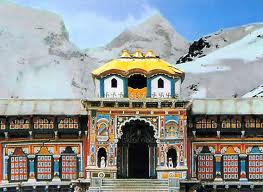
It is considered the holiest of the four main shrines of Uttarakhand. Badrinath is one of the itinerary of the every devout Hindu. The present temple was built about 2 centuries ago by the Kings of Gharwal. The principal idol in the temple is of black stone and represents Lord Vishnu seated in a meditative pose, and flanked by Narayan. Badrinath is also known as Vishal Badri. The temple remains closed from October to April due to severe winter conditions. The famous hot spring of Taptkund and Suryakund are just below the temple. A dip considered holy and refreshing to the body as well as the soul is a must before offering prayers to Shri Badrinath.
Kedarnath : Set amidst the stunning mountains cape of the Gharwal Hills, Ked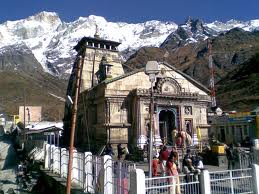 arnath at the head of the Mandakini river, is a very holy pilgrimage. It is located at the height of 11,742 feet(3580 m), is a famous pilgrim site for Lord Shiva devotees. According to the legend, Lord Shiva wished to elude the Pandavas and took refuge in Kedarnath. The lingam at Kedarnath, unlike it's usual form is pyramidal and is regarded as one of the 12 Jyotilingas. The shrine is closed on the first day of Kartik (Oct-Nov) and reopened in Vaishakh (Apr-May). During 9 months of closure the shrine is submerged in snow and worship is performed at Ukhimath.
arnath at the head of the Mandakini river, is a very holy pilgrimage. It is located at the height of 11,742 feet(3580 m), is a famous pilgrim site for Lord Shiva devotees. According to the legend, Lord Shiva wished to elude the Pandavas and took refuge in Kedarnath. The lingam at Kedarnath, unlike it's usual form is pyramidal and is regarded as one of the 12 Jyotilingas. The shrine is closed on the first day of Kartik (Oct-Nov) and reopened in Vaishakh (Apr-May). During 9 months of closure the shrine is submerged in snow and worship is performed at Ukhimath.
Gangotri : The Ganges is India's most sacred river. Hindus believe its waters to have flowed eternally. It's source is said to be the summit of Mt. Meru; the mythical mountain at the centre of the universe. F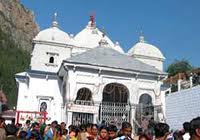 rom there the river descends to earth via Lord Shiva's matted hair, which cushions it's falls. It is worshipped by Hindu's as the goddess Ganga and the great cities of Varanasi, Allahabad and Hardwar on it's banks are amongst the most important pilgrim places in India. Pilgrims bathe in the Ganges to cleanse themselves of the Marma of previous and current lives, and so ensure an auspicious rebirth. The closest temple to the sources of Ganges lies 10,300 feet up in the small mountain village of Gangotri, half days climb on foot from the town Rishikesh. "Gaumukh" the actual source of the Ganges is at 13,858 feet; a further days walk ahead to where the Gangotri glacier meets the Bhagirathi river. Prayer plags and small shrines mark the source. A good place to meditate in solitude.
rom there the river descends to earth via Lord Shiva's matted hair, which cushions it's falls. It is worshipped by Hindu's as the goddess Ganga and the great cities of Varanasi, Allahabad and Hardwar on it's banks are amongst the most important pilgrim places in India. Pilgrims bathe in the Ganges to cleanse themselves of the Marma of previous and current lives, and so ensure an auspicious rebirth. The closest temple to the sources of Ganges lies 10,300 feet up in the small mountain village of Gangotri, half days climb on foot from the town Rishikesh. "Gaumukh" the actual source of the Ganges is at 13,858 feet; a further days walk ahead to where the Gangotri glacier meets the Bhagirathi river. Prayer plags and small shrines mark the source. A good place to meditate in solitude.
HARIDWAR: Hardwar or Haridwar are two names for the same place. The whole of Uttarakhand is dotted with temples of Vishnu and Shiva. Vishnu is known as Hari and Shiva as Har. Dwar means gate, and it is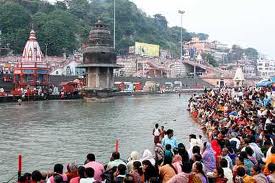 for this reason that this place is known as Hardwar or Haridwar, as it is the Gateway to Shri Badrinath and Shri Kedarnath, the holy shrines of Hari and Har. The Hindu Pantheon allows freedom of worship of Gods in any form. Uttarakhand abounds in shrines of god and goddesses and Haridwar from time immemorial has been the gateway to these shrines.It is said that Haridwar was the place of meditation for many ancient sages. Sage Kapil meditated here and for that reason this place was for several years known as Kapilasthan.
for this reason that this place is known as Hardwar or Haridwar, as it is the Gateway to Shri Badrinath and Shri Kedarnath, the holy shrines of Hari and Har. The Hindu Pantheon allows freedom of worship of Gods in any form. Uttarakhand abounds in shrines of god and goddesses and Haridwar from time immemorial has been the gateway to these shrines.It is said that Haridwar was the place of meditation for many ancient sages. Sage Kapil meditated here and for that reason this place was for several years known as Kapilasthan.
RISHIKESH:
It is said when Raibhya Rishi did hard penances, God appeared by the name of "Hrishikesh" and this area wa henceforth call by the name.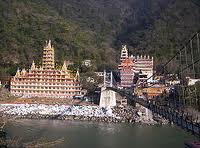
Rishikesh, situated on the right bank of river Ganga and surrounded on three sides by Himalayan ranges, known from medieval time as celestial abode, is a great pilgrimage centre of India, attracting a large number of pilgrims. It is believed that Bharat brother of Lord Rama, subjected himself to severe penance here. A temple known as Bharat Temple was later constructed at the site and the town Rishikesh sprang up around the temple. It has since been the abode of saints and sages from where tey sojourn before undertaking the arduous pilgrimage that lay ahead on the distant Himalayan peaks.
This gateway to the kingdom of Gods and pilgrimage to Badrinath, Kedarnath, Gangotri and Yamunotri is clustered with Ashram, Tourist Rest House and Dharamsalas.
The Yoga centres of Rishikesh have enhanced the significance of the place, home and foreign tourist from all over the world visit this place to have lessons in Yoga and Meditation.
UTTARKASHI :
On the banks of the Bhagirathi, surrounded by the rivers Varuna and Assi, this sacred, fast developing town is the capital of the newly constituted westernmost district of the Uttarakhand Sub-division along the Indian border. This is a town chokeful of temples, historical monuments, 'ashrams' and 'dharamsalas'. It is a 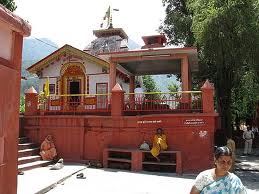 Shiva town populated by 12,000 people. He is the presiding deity and is worshipped morning, noon and night in the ancient temple of Lord Vishwanath. The evening song evokes an atmosphere of beauty in religion as the music of chanting bells mingles with the chants of the pandits. Within the courtyard and directly opposite the temple is the Shakti Temple dedicated to the Goddess of Energy, projecting a massive brass trident which, according to an inscription in Sanskrit engraved on it reveals that the temple of Vishwanath was built by king Ganeshwar, Whose son, Guh a great warrior, had the trident forget. It is 8 meters (26 ft) and atop measuring 2.74metres (95 ft) and atop measuring almost a meter in circumference. Another inscription bearing trident, on a smaller scaler, can be found in the Shiva Temple in the town of Gopeshwar, near Chamoli.
Shiva town populated by 12,000 people. He is the presiding deity and is worshipped morning, noon and night in the ancient temple of Lord Vishwanath. The evening song evokes an atmosphere of beauty in religion as the music of chanting bells mingles with the chants of the pandits. Within the courtyard and directly opposite the temple is the Shakti Temple dedicated to the Goddess of Energy, projecting a massive brass trident which, according to an inscription in Sanskrit engraved on it reveals that the temple of Vishwanath was built by king Ganeshwar, Whose son, Guh a great warrior, had the trident forget. It is 8 meters (26 ft) and atop measuring 2.74metres (95 ft) and atop measuring almost a meter in circumference. Another inscription bearing trident, on a smaller scaler, can be found in the Shiva Temple in the town of Gopeshwar, near Chamoli.
Among the other temples in this many splendor town are the parashuram, Kali and that of the Ekadash Rudra, built by the former Maharaja of Jaipur and where in the days of yore, two brave heroes, Kirat and Arjun dwelled till death took Kirat. Above the town is the temple of Sri Chandreshwar, situated on Varunavat Parbat with commanding magnificence and grandeur. Besides the Anglo-Sanskrit College, and the Old seat of the Deputy Collector, there are the Kshettras of the Baba kali Kamli Wala, the Maharaja of Jaipur and the Punjab sind Kshettra.
